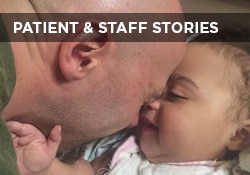This website uses cookies so that we can provide you with the best user experience possible. Cookie information is stored in your browser and performs functions such as recognising you when you return to our website and helping our team to understand which sections of the website you find most interesting and useful.

Susan E. Mazer, Ph.D. Blog
Thoughts and ideas on healthcare
Hi, and welcome to my blog! I'm Susan E. Mazer -- a knowledge expert and thought leader on how the environment of care impacts the patient experience. Topics I write about include safety, satisfaction, hospital noise, nursing, care at the bedside, and much more.
Patient Safety: It’s About the Culture!
November 15, 2013
 This week, I spoke at the Hospital Council of Northern and Central California’s Patient Safety Exchange, an annual event that brings together nurses and administrators, physicians and risk officers, and others who are directly involved with patient safety. These are people who are both responsible and accountable for keeping patients safe.
This week, I spoke at the Hospital Council of Northern and Central California’s Patient Safety Exchange, an annual event that brings together nurses and administrators, physicians and risk officers, and others who are directly involved with patient safety. These are people who are both responsible and accountable for keeping patients safe.
My presentation, based on two of my published articles, looked at the role of hospital noise in the safety profile for each patient, with the key being creating a culture of safety. It is here that the work is far more relevant and solutions more sustainable.
Florence Nightingale, in her Notes on Hospitals, stated unequivocally that the first obligation of a hospital, as obvious as it may sound, is to do no harm to its patients.
Nightingale was referring to everything, including not only those who care for patients, but the environment in which they are cared for. No exceptions or exemptions. Ever.
Currently, every rule or regulation first defines exactly who and what is included, followed by a list of of those excluded. The rationale for either may be the size of an organization, its focus, or its bottom-line financial profile.
And is anyone in the hospital actually exempt from any kind of safety regulation just because they dress differently or are non-clinical personnel?
It was stated over and over at Patient Safety Exchange that it is about safety first and foremost. The Patient Safety First campaign of the Northern and Central California Hospital Council and the Southern California Hospital Council has shown outstanding results.
Today, any and all safety initiatives apply to every person, even individuals who may only visit the hospital, such as visitors, vendors or repairmen. Handwashing gels are now outside of each hospital room, with visitors being educated to wash their hands, not only staff. A good example of shared responsibility.
Perhaps the only exemption or exception to any of this are patients, who cannot, given their circumstances, do all that is necessary to take care of themselves or prevent injury. For this reason, hospital personnel and family members necessarily act on behalf of the patient.
That said, patients’ roles begin anew upon discharge, when they are handed back their lives and all the rights and responsibilities that go with it.
Dr. Warren Browner, MD, CEO of California Pacific Medical Center (CPMC), reports that CPMC has instituted mandatory self-report of any error, accident, or mishap and the only basis for immediate termination is a willful cover-up. Browner and others in his role have stated and statistics have shown that blame-free transparency is the only way to improve outcomes, reduce risk, keep safety at the forefront. No exceptions.
Substantial and measurable improvements are being pushed for in U.S. hospitals, beginning in 2005 with the 100,000 Lives Campaign initiated by the Institute for Health Improvement. To date, many more hundreds-of-thousands of lives have been saved, but safety in real time is as dynamic an event as errors in real time. Once safety mechanisms are put in place for the obvious challenges, the next layer shows up.
Medical alarm fatigue is a good example of a solution becoming a problem. At this time, every patient in the hospital is put on heart monitors — and no one is really prepared to decide who may not need one. The result is so many alarms going off that are non-actionable that either the alarms are not heard or not responded to.
Systems and practices are being developed that acknowledge and integrate the combined roles of human factors, need, skills, and practice. In real time.
For example, Dr. Browner described habituation to reporting tools, like checklists, as risky, equal to having no checklist. CPMC ended the written checklist and replaced it with a time-out, which included the staff reading aloud the various questions and requirements to ensure all was done properly: right patient, right surgery, right medication, etc.
We have so far to go in a world where complexity is the norm and simplicity is a craving. Sustainable reduction of patient harm must be inherent to the culture of the hospital.
Nightingale stated it in a way any of us might today:
It may seem a strange principle to enunciate as the very first requirement in a hospital that it should do the sick no harm. It is quite necessary, nevertheless, to lay down such a principle, because the actual mortality in hospitals, especially in those of large crowded cities, is very much higher than any calculation founded on the mortality of the same class of diseases among patients treated out of the hospital would lead us to expect.










